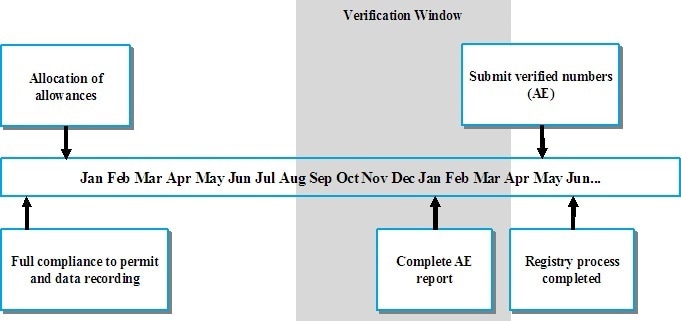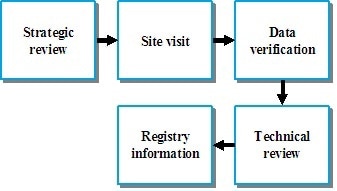Aug 22 2016
Complying with European Union Emission Trading System (EU ETS) requirements has its own legal obligations, but vital commercial gains should also be taken into account. It is possible for fuel efficient airlines to sell credits not used from their predetermined allowance at the market value (projected to be €5 to €12/tCO2). However, these airlines will first have to have their emissions checked, verified, and recorded.
Understanding the best way to perform checking, verification, and reporting of CO2 for both Tonnes-Kilometre figure (TK) and Annual Emissions figure (AE) figures can be a difficult task. Individuals in the aviation field must take extreme care to make sure that verification is properly executed in order to decrease the occurrence of risks - both reputational and financial - of misreporting.

Figure 1. Annual timeline of EU ETS monitoring, verification and recording
Strategy
A structured and well-defined approach will help to ensure compliance. Given below are a few major principles for a Monitoring and Reporting Plan (MRP), applicable for all CO2 verification sectors and schemes globally:
- Transparency - addressing all significant issues in a coherent and factual manner, based on a clear audit trail
- Accuracy - ensuring that the quantification of emissions is neither systematically overstated or understated, and that uncertainties are decreased as far as possible
- Comparability - the use of a technique that allows accurate comparisons between similar organisations to be obtained
- Consistency - the application of reliable methodologies in order permit meaningful comparisons of emissions over time
- Completeness - all emission activities and sources are accounted for
Considering these points, Lucideon devised a five step strategy to ensure that verification is executed in an accurate, reliable, and consistent manner. This is illustrated in Figure 2.

Figure 2. Five step strategy for verification
An annual strategic review enables an initial overview of the organisation to be obtained, and helps to detect any existing issues, risks, or changes that could impact both the accurate gathering of data and compliance.
Additionally, management system procedures are analysed to make sure that they do not cause any problems to the verification process. This article presents a complete verification plan, including data sampling procedure and risk assessment.
In the aviation sector, the site visit is almost always carried out at the head office and not at the airport, as this is where the flight details are collected and stored.
For small emitters, there is almost always the scope to carry out the verification as a remote engagement, assuming specific criteria are fulfilled. This allows the verification process to be more cost-effective, less intrusive, and executed with a reduced carbon footprint itself.
The initial step is to confirm if the airline meets the scheme entry requirements. The next step is to analyse the scope and boundaries of the data collection. A vital consideration is to identify exclusions that could result in a major undercounting of emissions or over allocation of allowances if not taken into account. For example, whether all aircrafts should be included in verification.
The next step is to define and verify data sources as adequate, with close attention paid to the methodology being applied to gather and examine data. It is important to ensure the correct procedure is used for the different fuel sources in use, specifically for aviation organisations. There are several methodologies currently used to do this even within the same airline, and it is crucial that one must be used consistently.
It is possible to gather and verify draft part-year data where required, and an individual summary “shopping list” report is also needed to highlight any extra information.
Further steps are carried out in the verification window. The time duration leading up to the March end of the process is required to make sure that all tasks are completed within the stipulated time period.
The first step is data verification itself. Transparency is considered to be a major issue, and all data must be validated back to its initial source, such as invoices, the captain’s log, or a fuel docket.
Calculations are evaluated, and data is cross-checked with alternative sources where appropriate. Errors or missing data are corrected and all major problems from the site visit stage are completely addressed.
After completing these steps an annual emissions report is prepared, which then forms the basis of a draft Verification Opinion Statement (VOS).
An independent technical review is a major aspect linked to the reliability of the final VOS. The reviewer must have absolutely no role in the entire verification process for the organisation in question, and is required only to re-evaluate all calculations, including the rules and methodology used.
The reviewer must ensure that the issues raised at the site visit stage have been dealt with. After completing all of these tasks, the reviewer is finally allowed to approve the draft VOS.
During the final stage - known as registry interaction - the VOS is submitted for examination and approval to the Competent Authority, and the final verified figures are added into the EU ETS Registry. The client organisation recommends their emissions data based on the VOS, and this is then sanctioned by the verifier.
Challenges
The specific tasks involved in the verification of CO2 emissions differ from one sector to another, and the aviation industry has its own particular issues. What are the major considerations, and how can airlines assist the verification process to run smoothly?
Data sampling is a major consideration, with information gathered from potentially thousands of flights to be considered for any given organisation. Sampling enables verifiers to detect potential issues and undertake additional sampling if required.
Three principle categories include:
- "Sense check" – comparison of fuel consumption for varied aerodrome pairs
- Vertical – fuel consumption per aerodrome pair over time
- Horizontal – the on-board fuel uplift data against fuel delivery dockets
The entire process can be performed smoothly by ensuring that precise and comprehensive data is ready for evaluation. Accurate sampling can become a difficult task when there is a lack of original source documents, poor audit trail of source data, data transposition errors, and outdated emission factors are used.
Verification can be difficult if the data collected has uncertainty issues. One source of this is linked to possible exemptions and the eligibility of specific flights, and it is vital to ensure that only eligible sources of emissions are considered during assessment and verification.
Another reason for uncertainty comes from the role of measurement instruments for calculating fuel uplift, fuel density, and fuel in tanks. To prevent such uncertainties, particular courses are available exclusively for the topic of verification uncertainty.
In the aviation sector the verifier’s role is to examine the “validity of the information used” in terms of discrepancies fed into the uncertainty analysis, and not to repeat the analysis itself. This can take longer and will need more resources, emphasising the fact that measurement instruments should be properly maintained, as it will take a long time to deal with such problems.
The aircraft manual highlights the accuracy needed for aircraft fuel systems, and this will form a major part of uncertainty verification.
Associated to this are the challenges presented by fuel sampling. Several airlines use one or more of the three main fuel classes, such as aviation gasoline, jet gasoline, and jet kerosene, which are categorised as commercially traded fuels and have conventional emission factors so they are fairly easy to be considered.
For alternative biofuels and fuels, additional procedures are required in order to establish Net Calorific Values (NCV) and Emission Factors (EF).
Sustainable alternative fuels will play a crucial role in the future of aviation, but airlines should be aware of the current work dealing with the assessment of data obtained from these sources, compared to those with conventional emission factors.
It is also necessary to have accurate fuel-specific gravity, and the airline should be confident that the airport has carried out proper documentation. It is important that three decimal places are used to prevent errors when calculations are made.
The use of consistent and systematic procedures is vital across all sectors of EU ETS. This is in no way different for the MRP used to develop AE and TK data, and airlines must implement accepted internal reviews and procedures, which will be examined by verifiers.
It is necessary for these procedures to have adequate risk assessments as this will help to detect and prevent potential barriers to successful verification wherever possible. For instance, unexpected changes in key personnel can have a significant impact on verification, but can be considered for at the risk assessment stage.
Conclusion
Aviation CO2 monitoring and reporting plays a key role in the ongoing fight to stop climate change. Aircraft and airlines operators need to develop confidence in the ability of the verifiers they are associating with, and in their own ability to collect data in an accurate manner.
The need to have consistent and reliable procedures to enable airlines to fulfil their legal obligations and ensure that they are best placed to benefit when trading cannot be understated.

This information has been sourced, reviewed and adapted from materials provided by Lucideon CICS.
For more information on this source, please visit Lucideon CICS.